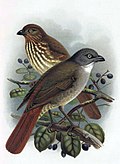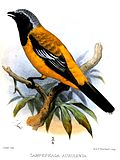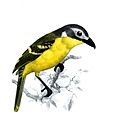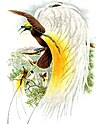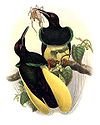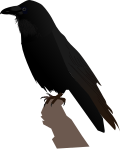Figbird: Difference between revisions
Pvmoutside (talk | contribs) No edit summary |
→Taxonomy and systematics: add image |
||
| (13 intermediate revisions by 12 users not shown) | |||
| Line 1: | Line 1: | ||
{{Short description|Genus of birds}} |
|||
{{Automatic |
{{Automatic taxobox |
||
| name = Figbird |
| name = Figbird |
||
| image = Green Figbird samcem.JPG |
| image = Green Figbird samcem.JPG |
||
| image_caption = [[Australasian figbird]] (''Sphecotheres vieilloti'') |
| image_caption = [[Australasian figbird]] (''Sphecotheres vieilloti'') |
||
| taxon = Sphecotheres |
| taxon = Sphecotheres |
||
| authority = [[Louis |
| authority = [[Louis Pierre Vieillot|Vieillot]], 1816 |
||
| type_species = ''[[Green figbird|Sphecotheres viridis]]''<ref name=HM4>{{cite web |url= https://www.aviansystematics.org/4th-edition-checklist?viewfamilies=146 |title= Oriolidae |author=<!--Not stated--> |date= |website= aviansystematics.org |publisher= The Trust for Avian Systematics |access-date= 2023-07-16}}</ref> |
|||
| type_species_authority = Vieillot, 1816 |
|||
| subdivision_ranks = Species |
| subdivision_ranks = Species |
||
| subdivision = |
| subdivision = See text |
||
| synonyms = * ''Picnorhamphus'' <small>Rosenberg, 1867</small> |
| synonyms = * ''Picnorhamphus'' <small>Rosenberg, 1867</small> |
||
* ''Sphecotera'' |
* ''Sphecotera'' |
||
}} |
}} |
||
The '''figbirds''' are a [[genus]] ( |
The '''figbirds''' are a [[genus]] (''Sphecotheres'') in the family of [[Old World oriole]]s found in wooded habitats in Australia, [[New Guinea]], and the [[Lesser Sundas]]. |
||
==Taxonomy and systematics== |
==Taxonomy and systematics== |
||
Formerly, the three species have been considered [[conspecific]], but |
Formerly, the three species have been considered [[conspecific]], but all major authorities now consider them as separate species.<ref name=HBW>Higgins, P. J., L. Christidis, & H. A. Ford (2008). Family Oriolidae (Orioles). Pp. 692-731 in: del Hoyo, J., A. Elliott, & D. A. Christie. eds. (2008). ''Handbook of the Birds of the World.'' Vol. 13. Pendulin-tits to Shrikes. Lynx Edicions. {{ISBN|978-84-96553-45-3}}</ref><ref name=H&M>Dickinson, E. C. (editor) (2003). ''The Howard and Moore Complete Checklist of the Birds of the World.'' 3rd edition, w. updates. Christopher Helm. {{ISBN|0-7136-6536-X}}</ref><ref name=indonesia>Andrew, P. (1992). ''The Birds of Indonesia: A Check-list.'' Kukila Check-list No. 1. Indonesian Ornithological Society, Jakarta.</ref><ref name=GillWright>Gill, F., M. Wright, & D. Donsker (2009). ''[http://www.worldbirdnames.org/ IOC World Bird Names].'' Version 2.1. Accessed 04-07-2009</ref><ref name=ChristidisBoles>Christidis, L., & W. E. Boles (2008). ''Systematics and Taxonomy of Australian Birds.'' CSIRO. {{ISBN|978-0-643-06511-6}}</ref> The split is primarily based on differences in measurements, [[plumage]], and [[biogeography]]. |
||
===Species=== |
===Species=== |
||
Three [[species]] are recognized:<ref>{{Cite web|url=http://www.worldbirdnames.org/bow/orioles/|title=Orioles, drongos & fantails « IOC World Bird List|website=www.worldbirdnames.org|language=en-US|access-date=2017-02-20}}</ref> |
Three [[species]] are recognized:<ref>{{Cite web|url=http://www.worldbirdnames.org/bow/orioles/|title=Orioles, drongos & fantails « IOC World Bird List|website=www.worldbirdnames.org|language=en-US|access-date=2017-02-20}}</ref> |
||
{| class="wikitable sortable" |
|||
* [[Green figbird]] (''Sphecotheres viridis'') |
|||
|- |
|||
| ⚫ | |||
! Image !! Common name !! Scientific name !! Distribution |
|||
* [[Australasian figbird]] (''Sphecotheres vieilloti'') |
|||
|- |
|||
|[[File:Voyage autour du monde (Pl. 21) BHL41621388 (cropped).jpg|120px]] || [[Green figbird]]||''Sphecotheres viridis''|| Indonesian islands of Roti and Timor |
|||
|- |
|||
| ⚫ | |||
|- |
|||
|[[File:Sphecotheres vieilloti -Bellenden Ker Range, Queensland, Australia -pair-8.jpg|120px]] ||[[Australasian figbird]] ||''Sphecotheres vieilloti''|| northern and eastern Australia, southern New Guinea, and the Kai Islands |
|||
|- |
|||
|} |
|||
==Description== |
==Description== |
||
| Line 26: | Line 37: | ||
==Behaviour and ecology== |
==Behaviour and ecology== |
||
Compared to the "typical" Old World orioles of the genus ''[[Oriolus]]'', the figbirds are more [[frugivorous]] (though they also take some small insects, nectar and seeds) and gregarious, even breeding in small, loose [[Bird colony|colonies]] (at least for the Australasian figbird; the nesting habits are still unknown for the other two species).<ref name=HBW/> |
Compared to the "typical" Old World orioles of the genus ''[[Oriolus]]'', the figbirds are more [[frugivorous]] (though they also take some small insects, nectar, and seeds) and gregarious, even breeding in small, loose [[Bird colony|colonies]] (at least for the Australasian figbird; the nesting habits are still unknown for the other two species).<ref name=HBW/> |
||
==References== |
==References== |
||
{{Reflist}} |
{{Reflist}} |
||
{{Corvides|C.|state=collapsed}} |
|||
{{Taxonbar|from=Q2417877}} |
{{Taxonbar|from=Q2417877}} |
||
[[Category:Sphecotheres| |
[[Category:Sphecotheres| ]] |
||
[[Category:Birds |
[[Category:Birds of Indonesia]] |
||
[[Category: |
[[Category:Taxa named by Louis Pierre Vieillot]] |
||
[[Category:Birds of the Lesser Sunda Islands]] |
|||
Latest revision as of 14:26, 15 November 2024
| Figbird | |
|---|---|

| |
| Australasian figbird (Sphecotheres vieilloti) | |
| Scientific classification | |
| Domain: | Eukaryota |
| Kingdom: | Animalia |
| Phylum: | Chordata |
| Class: | Aves |
| Order: | Passeriformes |
| Family: | Oriolidae |
| Genus: | Sphecotheres Vieillot, 1816 |
| Type species | |
| Sphecotheres viridis[1] Vieillot, 1816
| |
| Species | |
|
See text | |
| Synonyms | |
| |
The figbirds are a genus (Sphecotheres) in the family of Old World orioles found in wooded habitats in Australia, New Guinea, and the Lesser Sundas.
Taxonomy and systematics
[edit]Formerly, the three species have been considered conspecific, but all major authorities now consider them as separate species.[2][3][4][5][6] The split is primarily based on differences in measurements, plumage, and biogeography.
Species
[edit]Three species are recognized:[7]
| Image | Common name | Scientific name | Distribution |
|---|---|---|---|
 |
Green figbird | Sphecotheres viridis | Indonesian islands of Roti and Timor |
| Wetar figbird | Sphecotheres hypoleucus | Indonesian island of Wetar | |
 |
Australasian figbird | Sphecotheres vieilloti | northern and eastern Australia, southern New Guinea, and the Kai Islands |
Description
[edit]They are strongly sexually dimorphic, with males having olive-green upperparts, a black head, and (uniquely for the family) distinct bright red facial skin.[8][9] Females are drab-coloured, being dull brownish above, and white below with strong dark streaking. They have greyish facial skin, and a greyish-black bill.[8][9]
Behaviour and ecology
[edit]Compared to the "typical" Old World orioles of the genus Oriolus, the figbirds are more frugivorous (though they also take some small insects, nectar, and seeds) and gregarious, even breeding in small, loose colonies (at least for the Australasian figbird; the nesting habits are still unknown for the other two species).[2]
References
[edit]- ^ "Oriolidae". aviansystematics.org. The Trust for Avian Systematics. Retrieved 2023-07-16.
- ^ a b Higgins, P. J., L. Christidis, & H. A. Ford (2008). Family Oriolidae (Orioles). Pp. 692-731 in: del Hoyo, J., A. Elliott, & D. A. Christie. eds. (2008). Handbook of the Birds of the World. Vol. 13. Pendulin-tits to Shrikes. Lynx Edicions. ISBN 978-84-96553-45-3
- ^ Dickinson, E. C. (editor) (2003). The Howard and Moore Complete Checklist of the Birds of the World. 3rd edition, w. updates. Christopher Helm. ISBN 0-7136-6536-X
- ^ Andrew, P. (1992). The Birds of Indonesia: A Check-list. Kukila Check-list No. 1. Indonesian Ornithological Society, Jakarta.
- ^ Gill, F., M. Wright, & D. Donsker (2009). IOC World Bird Names. Version 2.1. Accessed 04-07-2009
- ^ Christidis, L., & W. E. Boles (2008). Systematics and Taxonomy of Australian Birds. CSIRO. ISBN 978-0-643-06511-6
- ^ "Orioles, drongos & fantails « IOC World Bird List". www.worldbirdnames.org. Retrieved 2017-02-20.
- ^ a b Simpson, K. (editor) & N. Day (illustrator) (1994). Field Guide to the Birds of Australia. 2nd edition. Christopher Helm. ISBN 0-7136-3930-X
- ^ a b Coates, B. J., & K. D. Bishop (1997). A Guide to the Birds of Wallacea. Dove Publications Pty. Ltd. ISBN 0-9590257-3-1

